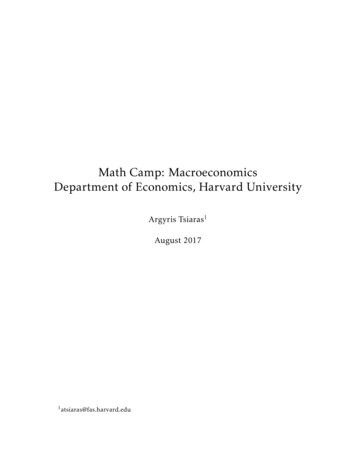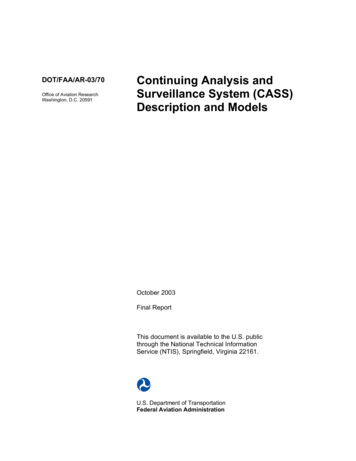
Transcription
Math Camp: MacroeconomicsDepartment of Economics, Harvard UniversityArgyris Tsiaras1August 20171 atsiaras@fas.harvard.edu
ii
ContentsOverviewv1 Continuous Dynamical Systems: Solution Methods1.1 Introduction . . . . . . . . . . . . . . . . . . . . . . . . . . . .1.2 Basic Results in Linear Algebra . . . . . . . . . . . . . . . . .1.2.1 Linear Map, Change of Basis . . . . . . . . . . . . . . .1.2.2 Eigenvalues and eigenvectors . . . . . . . . . . . . . .1.3 Solutions of Autonomous Linear Systems . . . . . . . . . . . .1.3.1 Homogeneous Systems . . . . . . . . . . . . . . . . . .1.3.2 Nonhomogeneous Systems . . . . . . . . . . . . . . . .Application 1.1 The Cobb-Douglas Solow Growth Model . .Application 1.2 Liquidity Traps in the New Keynesian Model1.4 Solutions of General (Nonautonomous) Linear Systems . . . .1.4.1 Homogeneous Systems . . . . . . . . . . . . . . . . . .1.4.2 Nonhomogeneous Systems . . . . . . . . . . . . . . . .1.4.2.1 Forward Solutions . . . . . . . . . . . . . . .1.4.3 A special class of nonautonomous systems . . . . . . .1.5 Two Special cases of nonlinear ODEs . . . . . . . . . . . . . .1.6 General Results on Properties of Solutions* . . . . . . . . . .11445779101218182022242527Problem Set 1312 Continuous Dynamical Systems: Stability Analysis2.1 Concepts of Stability . . . . . . . . . . . . . . . . . . . . . .2.2 Stability Analysis in Autonomous Linear Systems . . . . .2.2.1 Asymptotic Stability . . . . . . . . . . . . . . . . . .2.2.2 Saddle-path Stability . . . . . . . . . . . . . . . . . .2.2.3 The Dynamics of Planar Systems . . . . . . . . . . .2.3 Stability Analysis in Autonomous Nonlinear Systems . . .Application 2.1 Stability in the Neoclassical Growth Model2.4 Comparative Dynamics in Autonomous Systems* . . . . . .Application 2.2 Comparative Dynamics in the Solow Model35353636373940444750iii.
ivCONTENTS3 Discrete Dynamical Systems: Difference EquationsApplication 3.1 Global Stability in the Solow Model: Continuous vs.Discrete Time . . . . . . . . . . . . . . . . . . . . . . . . . . . .3.1 The Dynamics of Planar Systems . . . . . . . . . . . . . . . . . . . . .57Problem Set 2674 Discrete Dynamical Systems: Expectational Difference Equations4.1 The One-Dimensional Case . . . . . . . . . . . . . . . . . . . . . . . . .4.2 Equilibrium Determinacy . . . . . . . . . . . . . . . . . . . . . . . . .4.2.1 Local Determinacy and (Log)linearization* . . . . . . . . . . .4.3 The Blanchard-Kahn solution method . . . . . . . . . . . . . . . . . .4.3.1 Proof of Theorem 4.4* . . . . . . . . . . . . . . . . . . . . . . .Application 4.1 Solution to the Loglinearized Stochastic NeoclassicalGrowth Model . . . . . . . . . . . . . . . . . . . . . . . . . . . .Application 4.2 Equilibrium Determinacy and Monetary Policy* . . .737377778183Problem Set 3915 Dynamic Optimization: Optimal Control Theory5.1 The Lagrange Method in Discrete Time . . . . . . . . . . . .5.2 The Optimal Control Problem . . . . . . . . . . . . . . . . .5.3 Necessary and Sufficient Conditions for Optimality . . . . .Application 5.1 Hotelling Rule for nonrenewable resourcesApplication 5.2 Solution to the Neoclassical Growth Model.6063858795. 95. 97. 99. 105. 1086 Perturbation Methods*6.1 Loglinearization Methods . . . . . . . . . . . . . . . . . . . . . . . . . .Application 6.1 Loglinearization of the Stochastic Neoclassical GrowthModel . . . . . . . . . . . . . . . . . . . . . . . . . . . . . . . . .6.2 Nonlinear Perturbation Methods . . . . . . . . . . . . . . . . . . . . . .111111Main Sources119114115
OverviewIn this four-day mini-course, I will cover some important mathematical topics thatare relevant for the material taught in the first-year macro sequence. On the firsttwo days I will go over basic results in the theory of ordinary differential equations.On the second day I will also cover results on difference equations, which are verysimilar to differential equations with most results about the latter extending to theformer. On the third day I will present solution methods for (linearized) systems ofexpectational difference equations, that is, difference systems involving expectationsof future realizations of variables. These types of systems are particularly relevantfor the important class of dynamic stochastic general equilibrium (DSGE) models, animportant feature of which is the forward-looking nature of agents’ policies; you willlearn about DSGE models in the third quarter of the macro sequence. On the fourthday I will cover the theory of optimal control, which is an important method forsolving (deterministic) optimization problems in continuous time. Optimal controltheory is relevant for the second part of the macro sequence on economic growthas theories of economic growth have typically been formulated in continuous ratherthan discrete time, in contrast to most other areas of macroeconomics.I will not cover important mathematical topics that are explicitly covered in classduring the first-year sequence. In particular, I do not cover at all dynamic programming, by far the most important and widely used optimization method in economics(both in discrete and in continuous time); it deserves a course of its own, the firstquarter of the macro sequence.It is simply not possible for me to cover all of the aforementioned topics in fulldetail and for you to absorb all of this material, especially if you have not seen it before, within just four days of class. So, a large portion of the material in these noteswill not be covered in detail or at all in class. I wrote the following chapters, whichare quite comprehensive and include examples and economic applications chosenfor their relevance for the first-year macro sequence, with the intention that theyserve as a good reference for you during your first year and beyond. With this goalin mind, I also include an index of key terms so that you can use these notes as a reference more effectively. The starred sections and the last chapter on loglinearizationmethods (relevant for the third quarter of the macro sequence) will not be coveredin class; they are included for completeness and as a point of reference for furtherstudy.v
viOVERVIEWI have also prepared short, informal problem sets for you to work on after eachof the first three days of class. The problem sets are strictly optional; the course isnot graded in any explicit or implicit manner. The exercises are meant to incentivizeand help guide your review of the material after each day of class. The problemsets are not to be turned in; we will go over the problems and their solutions in thebeginning of class the following day.I have consulted a number of textbooks and papers in preparing these notes.These sources are all included in the bibliography and I provide a list with my mainsources for the material in each chapter at the end of this booklet, but I provideminimal citation of my sources within the text (with the exception of the sourcesof included figures) both for ease of exposition and due to the standard nature ofthe material covered (so that my source of the material, usually a textbook, does notnecessarily reflect origin of the concept or application).
Chapter 1Continuous Dynamical Systems:Solution MethodsThis chapter discusses solution methods for deterministic ordinary differential equation (ODE) systems.1.1IntroductionMost models in macroeconomics are formulated in discrete time. That is, there aretime periods t 0, 1, 2, . . . , where the unit of time is in general arbitrary and can refer to a day, a month, or a decade. This arbitrariness suggests that it may be helpful,especially when looking at model dynamics, to make the time unit as small as possible. Thus, a number of models in macroeconomics are formulated in continuoustime. When we compare continuous-time dynamical systems with discrete-time dynamical systems in Chapter 3, we will see that continuous systems have a number ofadvantages: they allow for a more flexible analysis of dynamics and allow for explicitsolutions in a wider set of circumstances. This is particularly so for heterogeneousagent models. In addition, a number of “pathological” results of models formulatedin discrete time disappear once we move to the corresponding continuous-time version of the model.Consider a function x : T R, where T is an interval in R. Given a real number t, function x satisfiesx(t t) x(t) G(x(t), t, t)where G(x(t), t, t) is a real-valued function. Divide both sides of this equation by t and consider the limit as t 0. We obtain the differential equationdx(t) g(x(t), t)(1.1)ẋ(t) dtwhereG(x(t), t, t)g(x(t), t) lim(1.2) t t 01
2CHAPTER 1. ODE SYSTEMS: SOLUTION METHODSis assumed to exist.More generally, a differential equation is an equation for an (unknown) function of one or more independent variables (in the example above, the independentvariable is time t) that relates the values of the function, the values of the (possibly higher-order) derivatives of the function, and the values of the independentvariables. If the function has a single independent variable it is called an ordinarydifferential equation (ODE). If, instead, the function is multivariate we have a partial differential equation. We will only cover ordinary differential equations in mathcamp.A differential equation is explicit if it is of the formx(n) (t) g(x(n 1) (t), . . . , x(t), t)(1.3)that is, the highest-order derivative of the differential equation is separated from theother terms. In contrast, an implicit differential equation has the formg(x(n) (t), x(n 1) (t), . . . , x(t), t) 0(1.4)We will only deal with explicit ODEs in math camp.A differential equation is of order n if the highest derivative appearing in theequation is of order n. It is autonomous if it does not explicitly depend on time (theindependent variable) as a separate argument. Otherwise, the differential equationis called nonautonomous. For example,ẋ(t) g(x(t))(1.5)is an autonomous first-order ODE.A differential equation is linear if it takes the forman (t)x(n) (t) an 1 (t)x(n 1) (t) · · · a1 (t)ẋ(t) a(t)x(t) b(t) 0(1.6)where a(t), a1 (t), . . . , an (t) and b(t) are arbitrary functions of time. It is nonlinear otherwise. Clearly, a linear differential equation is autonomous if and only if it hasconstant coefficients. Finally, a linear differential equation as in (1.6) with b(t) 0 tis called homogeneous.Boundary conditions are needed to pin down a specific solution to an ODE ofthe form (1.3) or (1.4). In general, we need n boundary conditions to pin down asolution to an ODE of order n. The most common form of an ODE problem is theinitial value problem, whereby an ODE, for example, a first-order ODE of the form(1.1) is specified together with an initial condition x(0) x0 . A solution to this initialvalue problem is a function x : T R that satisfies (1.1) for all t T with x(0) x0 .A family of functions {x : T R such that x satisfies (1.1) , t T } is often referredto as a general solution, while an element of this family that satisfies the boundarycondition is called a particular solution.
1.1. INTRODUCTION3Important ODE problems in economics are associated with boundary conditionsother than initial values. For example, a terminal value condition specifies what thevalue of x(t) should be at some finite horizon T and a transversality conditionspecifies what x(t) should be at the limit as t .An explicit ODE of the form (1.3) can be generalized by taking x(t) and g(·) tobe vector-valued functions, that is, x(t) : R Rm . We then have an m-dimensionalsystem of differential equations of the form (n) x1 (t) g1 (x(n 1) (t), . . . , x(t), t) (n) x (t) g (x(n 1) (t), . . . , x(t), t) 2 2 . (1.7). . . . (n) gm (x(n 1) (t), . . . , x(t), t)xm (t)where xi (t) refers to the ith component of vector x(t).A first-order ODE system of the form ẋ1 (t) g1 (x(t), t) ẋ (t) g (x(t), t) 2 2 . . . ẋm (t)gm (x(t), t)(1.8)will be the main focus of our analysis in this chapter. It may at first appear that (1.8)is a restrictive special case of (1.7) but this is not true. Any higher-order differentialequation or system can be transformed into an equivalent first-order ODE system byintroducing additional variables in vector x(t). For a concrete example, consider thesecond-order differential equation1 2 00b x (t) ax0 (t) ρx(t) 02(1.9)where b, a, and ρ are constants. Let y(t) denote a two-dimensional vector with y1 (t) x(t) and y2 (t) x0 (t). Then, (1.9) is equivalent to the first-order system" 0 # "# "#01y1 (t)y1 (t)(1.10) 2ρ2a · y (t)y20 (t) 222bbThus, there is no loss of generality in restricting our attention to (1.8). Incidentally, in the same vein one can transform any nonautonomous system like (1.8) intoan equivalent autonomous system by introducing the independent variable, t, as anadditional component of vector x(t). However, the latter transformation is not thatuseful. As we will see in Section 1.3, only autonomous systems have explicit solutions. In addition, only autonomous systems have steady states (equilibrium points)in general and are thus amenable to stability analysis, which is the focus of Chapter2.
4CHAPTER 1. ODE SYSTEMS: SOLUTION METHODS1.2Basic Results in Linear AlgebraIn this section we briefly review some concepts and results from linear algebra theory that we will use in our analysis of ODE systems in the following sections of thischapter.1.2.1Linear Map, Change of BasisRecall from the micro part of math camp the definition of a vector space. Importantexamples of vector spaces include the Euclidean space Rn for n N, the set of allinfinite sequences R , and the set of all functions from an arbitrary set S to R (in allof these examples the underlying scalar field is R).A (linear) subspace W V of a vector space is a subset of V that contains the zerovector, and for any x, y W , x y W and λx W , where λ is an arbitrary scalar. Asubspace of a vector space is itself a vector space.Let V be a vector space and let S be a nonempty subset of V . The span of S,denoted by span(S), is defined to be the set consisting of all linear combinations ofvectors in S. By convention, span( ) {0}. A vector space is finite-dimensional if it isspanned by a finite set of vectors, and infinite-dimensional otherwise.A set of vectors v1 , , v2 , . . . , vn V are linearly independent if a1 v1 a2 v2 · · · an vn 0, where a1 , , a2 , . . . , an are scalars, implies that a1 a2 · · · an 0. If a set B Vconsists of linearly independent vectors and B spans V then each element v V canbe uniquely expressed as a linear combination of the elements in B. Such a subset iscalled a basis of V . If V is finite-dimensional and B is a basis of V with n elements,then V is said to have dimension n. For example, the standard or Euclidean basis ofRn are the n n-dimensional vectors (1, 0, . . . , 0), (0, 1, . . . , 0),. . . , (0, 0, . . . , 1).Definition 1.1 (Linear map). A linear map from a vector space V to a vector space Uis a function L : V U such that L(v w) L(v) L(w), v, w V (additivity) L(λv) λL(v), v V , and λ F , where F is the underlying scalar field of V(homogeneity of degree 1)A linear ODE system, that is, a system of the form (1.8) where each functiongi (·, ·) is a linear function of its arguments, is an example of a linear map. It maps afunction (an element of a vector space of differentiable functions) to its derivative.Once the bases of the (finite-dimensional) vector spaces U and V in the definitionabove are specified, a matrix can capture all of the information of, and thus be idennntified with, map L. Assume V Rm with basis {vj }mj 1 and U R with basis {ui }i 1 .Then, the n-by-m matrix P [pij ] that corresponds to map L under the specifiedbases satisfiesL(vj ) p1j u1 · · · pnj un j 1, . . . , m(1.11)
1.2. BASIC RESULTS IN LINEAR ALGEBRA5Once we know P we can find the value of L(v) for any v V in the followingmway. Let c [cj ]mj 1 c(v, {vj }j 1 ) be the m-dimensional vector that represents vectorv under the specified basis: v c1 v1 · · · cm vm . Then,L(v) L(c1 v1 · · · cm vm ) c1 L(v1 ) · · · cm L(vm ) mm X X pnj cj unp1j cj u1 · · · j 1j 1 Pc(1.12)where the last line uses the convention that the ith component of a vector is thecoefficient of the ith element of a given basis of its vector space when the vector iswritten as a linear combination of that basis.An implication of this is that any (autonomous) linear ODE system can be writtenasẋ(t) A x(t)(1.13)where x(t) Rn , n N, A is an n n matrix, and x(t) is the representation of theunderlying vector with respect to the standard Euclidean basis of Rn , or asż(t) D z(t)(1.14)for a different n n matrix D where z is the representation of the same underlyingvector with respect to another basis of Rn . Matrices A and D, which represent thelinear map M(t) : Rn Rn associated with the same ODE system under differentbases, are called similar.How are the representations x(t) and z(t) of equations (1.13) and (1.14) relatedto each other? In our discussion of equations (1.11) and (1.12), take V U Rn ,so that m n, and {ui }ni 1 {ei }ni 1 (the standard Euclidean basis) and {vj }nj 1 are twodifferent bases of Rn , associated with representations x(t) and z(t), respectively. Thatis, map L now represents the change of basis from basis {vj }nj 1 to the standard basisof Rn (note that map L is different from map M associated with the ODE system in(1.13) and (1.14)). Then, z is precisely vector c in equation (1.12), so thatx(t) P z(t)(1.15)where the jth column of P corresponds to the standard Euclidean representation ofbasis vector vj .1.2.2Eigenvalues and eigenvectorsAn n n (square) matrix A is nonsingular or invertible if its determinant is not zero,det A , 0, or equivalently if the only n 1 column vector v that is a solution to
6CHAPTER 1. ODE SYSTEMS: SOLUTION METHODSequationAv 0(1.16)is the zero vector v (0, . . . , 0)T . In other words, the columns of an invertible matrixare linearly independent. If A is invertible, there exists matrix A 1 such that A 1 A In , where In is the n n identity matrix. Conversely, if there exists a nonzero solutionv to (1.16) or if det A 0, then A is singular and does not have an inverse.A complex number λ is an eigenvalue of A ifdet (A λIn ) 0(1.17)pA (λ) det (A λIn ) is a polynomial of order n in λ, called the characteristic polynomial of A. Thus, λ is an eigenvalue of A if and only if it is a root of its characteristicpolynomial. A is invertible if and only if none of its eigenvalues are equal to zero.Given the eigenvalue λ of A, the n 1 nonzero column vector vλ is an eigenvectorof A if(A λIn )vλ 0(1.18)Clearly, vλ can only be unique up to a normalization, since if vλ satisfies (1.18) thenso does avλ for any a R.Lemma 1.1. If λ1 , . . . , λk are k distinct eigenvalues of square matrix A, so that λi , λj forall i , j, then the associated eigenvectors vλ1 , . . . , vλk are linearly independent.From this lemma, it follows that if A has n distinct eigenvalues, then the associated eigenvectors form a basis of Rn , called the eigenbasis for A. A key result is thefollowing.Theorem 1.1 (Spectral Decomposition). Suppose n n matrix A has n distincteigenvalues. Then, A satisfiesA P DP 1(1.19)where D is the diagonal matrix with the eigenvalues λ1 , . . . , λn on the diagonal, andP (vλ1 , . . . , vλn ) is a matrix with the corresponding eigenvectors as its columns.Going back to our discussion of change of basis in the previous subsection, P,whose jth column is the (standard Euclidean representation of the) jth eigenvector,is associated with the linear map representing the change of basis from the eigenbasis to the standard Euclidean basis of Rn .The space spanned by the eigenvectors corresponding to a subset of eigenvaluesis called the eigenspace of matrix A associated with these eigenvalues and is a linear
1.3. SOLUTIONS OF AUTONOMOUS LINEAR SYSTEMS7subspace of Rn . In Section 2.2, we will see that the stable subspace of a (homogeneous) linear system is precisely the eigenspace associated with the system’s negativeeigenvalues (eigenvalues with negative real parts, if complex).Finally, note that when A has repeated eigenvalues, diagonalization is still possible through the use of generalized eigenvectors, which satisfy (A λIn )k vλ 0 forsome k N. However, in this case matrix D will be block diagonal rather than diagonal (it has the Jordan form). We will not cover this case in detail, although it isstraightforward.A final result we will make use of is summarized in the following Lemma:Lemma 1.2. Let A be an n n matrix with eigenvalues λ1 , . . . , λk and m1 , . . . , mk denotethe multiplicity of the corresponding eigenvalue. Then,(i) The determinant of A equals the product of its eigenvalues, repeated according totheir multiplicity,mmdet(A) λ1 1 · · · λk k(1.20)(ii) The trace of A, tr(A) (defined to be the sum of the diagonal entries of A), equals thesum of its eigenvalues, repeated according to their multiplicity.(iii) Let pA (λ) λn c1 λn 1 · · · cn be the characteristic polynomial of A. Thenc1 tr(A)cn ( 1)n det(A)In particular, when A is a 2 2 matrix with eigenvalues λ1 and λ2 ,pA (λ) λ2 tr(A)λ det(A) λ2 (λ1 λ2 ) λ λ1 λ21.3(1.21)(1.22)Solutions of Autonomous Linear SystemsIn this section, we will cover solutions to autonomous linear differential equationsand systems.1.3.1Homogeneous SystemsA linear first-order differential equation has the general formẋt a(t)x(t) b(t)(1.23)Recall that a linear differential equation (or ODE system) is autonomous if and onlyif it has constant coefficients. Thus, an autonomous first-order linear differentialequation takes the general form
8CHAPTER 1. ODE SYSTEMS: SOLUTION METHODSẋ(t) ax(t) b(1.24)Let us first consider the homogeneous linear equationẋ(t) ax(t)(1.25)We can divide both sides with x(t), integrate with respect to t, and recall that forx(t) , 0,Zẋ(t)dt log x(t) c0andx(t)Za dt at c1where c0 and c1 are constants of integration. Now, taking exponents on both sides,we obtain the general solution to (1.25),x(t) c exp(at)(1.26)where c is a constant of integration combining c0 and c1 . Suppose we are given aninitial condition x(0) x0 . This condition then pins down the unique value of theconstant of integration. In this case, c x0 .We can generalize this simple derivation to arrive at the solution of a homogeneous first-order system of the formẋ(t) Ax(t)(1.27)where x(t) Rn and A is an n n matrix.Under the assumption that A has n distinct real eigenvalues, we can transform(1.27) to an equivalent diagonal or “decoupled” system using Theorem 1.1. Thetransformed diagonal system is then simply a set of independent first-order linearhomogeneous equations of the form (1.25), which have the solution (1.26) as we havealready shown.As we discussed in the previous section, we need to perform a change of basisfrom the standard Euclidean basis to the eigenbasis. The relationship between therepresentation of the vector under the standard basis, x(t), and the representationof the same vector under the eigenbasis, z(t), is once again given by equation (1.15).We then haveż(t) P 1 ẋ(t) P 1 Ax(t) P 1 AP z(t) Dz(t)(1.28)whose solution is z1 (t) c1 exp(λ1 t), . . . , zn (t) cn exp(λn t), where λ1 , . . . , λn are the ndistinct eigenvalues of matrix A.We have thus derived the following result:
1.3. SOLUTIONS OF AUTONOMOUS LINEAR SYSTEMS9Theorem 1.2 (Solution to Homogeneous Autonomous Linear ODE Systems). Suppose n n matrix A has n distinct eigenvalues λ1 , . . . , λn . Then the unique solution to(1.27), ẋ(t) Ax(t), with initial value x(0) x0 takes the formx(t) nXcj exp(λj t)vλj(1.29)j 1where vλ1 , . . . , vλn are the eigenvectors corresponding to the eigenvalues λ1 , . . . , λn andc1 , . . . , cn denote the constants of integration (pinned down by the initial value condition).Theorem 1.2 applies only when all eigenvalues of A are real. What happens whensome of the eigenvalues are complex (with nonzero imaginary parts)? The methodand solution of Theorem 1.2 in fact still applies. Since A is a matrix with real entries,complex eigenvalues will always come in conjugate pairs. For example, assume Ahas two complex eigenvalues, λ1 α iµ and λ2 α iµ, where i 1 is theimaginary unit, and vλ1 d if and vλ2 d if are the corresponding eigenvectors.The remaining n 2 eigenvalues of A are real. Then, standard results in the theoryof complex numbers imply that the general solution of (1.27) has the formx(t) c1 exp(αt)(d cos(µt) f sin(µt)) c2 exp(αt)(f cos(µt) d sin(µt))nX cj exp(λj t)vλjj 3What happens when A has repeated eigenvalues? Recall our brief mention ofgeneralized eigenvectors and the Jordan form in the previous section. It turns outthat if A has k distinct eigenvalues λ1 , . . . , λk with multiplicities m1 , . . . , mk , respectively, the general solution to (1.27) has the formx(t) kXPi (t) exp(λi t)i 1mik XXpij t j 1 exp(λi t)i 1 j 1where Pi (t) is a polynomial in t with vector-valued coefficients.As will become clear later in the chapter, the case of n distinct real eigenvalues isby far the most relevant for economic applications.1.3.2Nonhomogeneous SystemsNext consider the autonomous but nonhomogeneous first-order linear equation
10CHAPTER 1. ODE SYSTEMS: SOLUTION METHODSẋ(t) ax(t) b(1.30)To derive the solution, use the change of variables y(t) x(t) ba . Writing (1.30)in terms of y(t),ẏ(t) ay(t)(1.31)which is a homogeneous linear equation, whose solution (1.26) we derived above.Transforming the equation back into x(t), we obtain the general solution to (1.30) asbx(t) c exp(at)a(1.32)Application 1.1 (The Cobb-Douglas Version of the Solow Growth Model). Considerthe key equation of the Solow growth modelk̇(t) sf (k(t)) δk(1.33)with initial condition k(0) k0 0. (1.33) says that capital (the capital-labor ratio), k(t), which is the state variable of the model, grows by an amount equal to newinvestment minus depreciation. Investment equals the exogenously given and constant savings rate of the economy, s (where 0 s 1), times output at time t, f (k(t)).Depreciation equals the exogenously given and constant depreciation rate, δ (where0 δ 1) times the level of capital at time t.We now solve (1.33) under the Cobb-Douglas specification for the output production function, f (k(t)) Ak(t)α , where 0 α 1. Thus, (1.33) becomesk̇(t) sAk(t)α δk(1.34)This is a nonlinear differential equation, so it appears that our results above arenot applicable to this problem. However, if we let x(t) k(t)1 α and express equation(1.34) in terms of this new auxiliary variable, we get a linear differential equation.Differentiating the definition of the auxiliary variable and applying the chainrule, ẋ (1 α)k α k̇. Then (1.34) impliesẋ sAk α δk(1 α)k αẋ (1 α)sA (1 α)δk 1 αẋ(t) (1 α)δx(t) (1 α)sAwhich is an autonomous, nonhomogeneous linear first-order differential equation inx(t). A direct application of formula (1.32) then givesx(t) sA c exp ( (1 α)δt)δ(1.35)
1.3. SOLUTIONS OF AUTONOMOUS LINEAR SYSTEMS11where c is the constant of integration, pinned down by the initial condition x(0) x0 k01 α : sAsA x0 exp ( (1 α)δt)(1.36)x(t) δδExpressing this in terms of k(t), we obtain the solution to our initial value problem1 1 αsA1 α sAk(t) k0 exp ( (1 α)δt)δδ (1.37)The solution reveals, in particular, that the economy converges to the steady-state1n o 1 αand the gap between k(t) and k̄ narrows at the exponenlevel of capital k̄ sAδtial rate (1 α)δ. That is, less diminishing returns to capital (higher α) and slowerdepreciation (lower δ) imply slower adjustment to the steady state. The derivation of (1.32) illustrates that nonhomogeneous linear equations andsystems, whether autonomous or nonautonomous, can be easily transformed intohomogeneous systems with a simple change of variables; yet, it is convenient toexplicitly derive the solution for nonhomogeneous systems of the formẋ(t) Ax(t) B(1.38)where B is an n 1 vector with constant coefficients.It turns out that the general solution of such a system can be written asxN (t) xH (t) xP (t)where xH (t) is the general solution of the corresponding homogeneous system, ẋ(t) Ax(t), and xP (t) is an arbitrary particular solution of the nonhomogeneous system.We will see in the next section that this holds for nonautonomous linear systems aswell.Since we already know how to compute the solution to the homogeneous system,we only need to find one particular solution of the nonhomogeneous system. Anobvious choice is the stationary solution of the system, denoted by x̄, whenever itexists. The stationary solution by definition satisfiesẋ x x 0 Ax̄ B x̄ A 1 Bprovided A is invertible (that is, it does not have any zero eigenvalues).We then obtain the following result, a direct analog to (1.32) for systems:
12CHAPTER 1. ODE SYSTEMS: SOLUTION METHODSTheorem 1.3 (Solution to Nonhomogeneous Autonomous Linear ODE Systems).Suppose n n matrix A has n distinct nonzero eigenvalues λ1 , . . . , λn . Then the uniquesolution to (1.38), ẋ(t) Ax(t) B, with initial value x(0) x0 takes the formx(t) x̄ nXcj exp(λj t)vλj(1.39)j 1where x̄ A 1 B is the unique stationary state of the system, vλ1 , . . . , vλn are theeigenvectors corresponding to the eigenvalues λ1
We will only cover ordinary differential equations in math camp. A differential equation is explicit if it is of the form x(n)(t) g(x(n1)(t);:::;x(t);t) (1.3) that is, the highest-order derivative of the differential equation is separated from the other terms. In contrast, an implicit differential equation has the form










